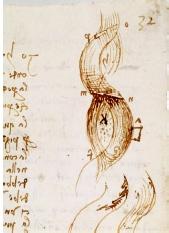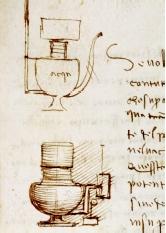Leonardo da Vinci
Italian Artist and Scientist 1452–1519
Leonardo da Vinci is history's foremost Renaissance man, a master of both art and science. Da Vinci is best known as the artist who created such masterpieces as the Mona Lisa, Madonna of the Rocks, and The Last Supper. Yet he was also a brilliant scientist, architect, engineer, and inventor. In fact, he was one of the best scientific minds of the Renaissance period, carrying out sophisticated research in fields ranging from architecture and civil engineering to astronomy and anatomy. The dynamics of water and the study of hydraulics were prominent among his many interests.
A Brief Chronology
Leonardo da Vinci was born in 1452 in the hills of Tuscany. As a child, he was a gifted artist and became an apprentice in one of the best art studios in Italy. By 1478, Leonardo became an independent master. He was hired into the court of Ludovico Sforza (Duke of Milan) when he was 30 years old and served as a painter, sculptor, musician, architect, and engineer. He also served as the principal engineer in the Duke's numerous military endeavors. Leonardo returned to Florence in 1499 when the Duke's family was driven from Milan by French forces.
In 1502, da Vinci entered the service of Duke Ceasare Borgia as his chief architect and engineer. There he completed many of his art and architectural works. The French governor summoned him back to Milan in 1506 where he became the court painter to King Louis XII of France, who had taken Milan from the Sforzas. He continued his many engineering projects during this time.
From 1514 to 1516, Leonardo lived in Rome under the patronage of Pope Leo X, and concentrated on his scientific studies while in the Vatican. Then in 1516, da Vinci traveled to France to enter the service of King Francis I. He died in France on May 2, 1519.
Notebooks
During the Renaissance period, there was a shift from purely philosophical endeavors toward observational or empirical science. Da Vinci's observational skills and data recording efforts were exceptional. His scientific legacy is found in his Notebooks. These handwritten manuscripts (approximately 8,000 pages survive) were apparently meant to be a great encyclopedia of knowledge, but, like many of his projects, it was never finished.
All of da Vinci's notes are written backwards, reportedly so that only someone intelligent enough to realize this fact could read them. It makes the manuscripts difficult to read, as does his use of peculiar spellings and abbreviations, and the lack of logical ordering and arrangement of the entries. For these reasons, the magnitude of the impact of his scientific work was not fully understood until later in the nineteenth century.
The Codex Leicester, written between 1506 and 1510, is the only notebook manuscript by da Vinci that is still privately owned, and the only one kept in America. (Bill Gates, Microsoft Corporation's chairman and chief software architect, paid $30.8 million in 1994 for the Codex Leicester manuscript.) This codex (unbound manuscript) was found in 1690 in an old chest in storage in Rome. Seventy-two pages in all, the Codex Leicester is a record of Leonardo's thoughts on a wide variety of topics, from astronomy to hydrodynamics, and includes his observations and theories related to the nature and properties of water. As in the rest of his notebooks, its pages feature his signature mirror writing.
Hydraulics.
Leonardo da Vinci's Notebooks reveal that the subject of hydraulics was his most frequently studied and recorded topic. Da Vinci made the first empirical studies of streams and their velocity distribution. He used a weighted rod held afloat by an inflated animal bladder. Da Vinci traced the velocity distribution across the stream's channel by releasing the rod at different places in the stream's cross-section. His inventiveness in devising scientific experiments was well ahead of his time.
Leonardo had plenty of time to observe nature during his years of service to the Duke of Milan (1482–1499). It is reported that he was an expert on the rocks and fossils found in northern Italy. He was fascinated by the idea of moving mountains or piercing them with tunnels. His Notebooks are full of observations he made on mountains and rivers, and they reveal that he understood the principle of sedimentation . He explained how rocks could be formed by the deposition of sediments by water, while at the same time rivers erode rocks and carry their sediments to the sea in a grand continuous cycle.
Hypotheses.
During the Renaissance, there were several hypotheses on why shells and fossilized forms of living creatures were found in rocks on the tops of mountains. Some believed the shells to have been carried there by the Biblical Flood, while others thought that these shells had grown in the rocks. Leonardo disliked both of these explanations and refuted them


Leonardo's answer to how shells came to be found on the mountaintops was very close to our modern understanding. Fossils were once-living organisms that were been buried at a time before the mountains were raised. He wrote, "It must be presumed that in those places there were sea coasts, where all the shells were thrown up, broken, and divided . . . . " In other words, where there is now land, there once was ocean. Much of his knowledge and observations on flooding dynamics came from the Arno River in northern Italy.
Arno Canals
In Arno, daVinci worked with Niccolo Machiavelli (1469–1527) on his lifelong dream of building a system of canals that would make the Arno River navigable from Florence to the sea. Machiavelli was a well-known political thinker of the Renaissance and author of The Prince. The treatise stood apart from all other political writings of that period in that it focused on the practical problems a ruler faced in retaining power, rather than the more speculative issues that explained the foundation of political authority and the pursuit of ideals.
In addition to being a great engineering feat, the canal project had economic and military purposes. Da Vinci envisioned irrigating the Arno valley and selling water to farmers to make money for the government. If they succeeded, da Vinci and Machiavelli would have transformed Florence into a major world power of the time. But in 1504, their plan failed after a flood destroyed much of their work. Some say Leonardo's obsession with this project is the motivation for the view of this valley in the background of the Mona Lisa, and it also drove his lifelong quest to understand the dynamics of water.
da Vinci's Legacy
Leonardo da Vinci's contribution to hydraulics and the understanding of water resources is not often the first thing historians associate with his brilliant life. Yet his wide-ranging interests and efforts to gather data to understand the world around him led to many significant advancements in knowledge, and remain an example to today's scientists, thinkers, and visionaries.
SEE ALSO Canals ; Infrastructure, Water-Supply ; Water Works, Ancient .
Faye Anderson
Bibliography
Masters, Roger D. Fortune is a River: Leonardo da Vinci and Niccolo Machiavelli's Magnificent Dream to Change the Course of Florentine History. New York: The Free Press, 1998.
Mays, Larry W. Water Resources Handbook. New York: McGraw-Hill, 1996.
Internet Resources
Leonardo. National Museum of Science and Technology, Milan. <http://www.museoscienza.org/english/leonardo/Default.htm> .
Leonardo da Vinci. Leonardo da Vinci Museum. <http://museum.brandx.net/main.html> .
Welcome to the Louvre Museum. The Louvre Palace and Museum, Paris. <http://www.louvre.fr/> .
Comment about this article, ask questions, or add new information about this topic: